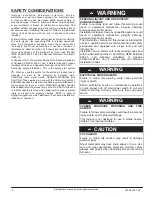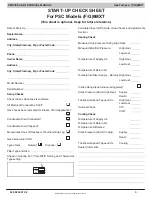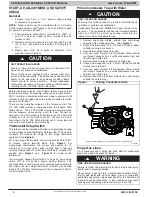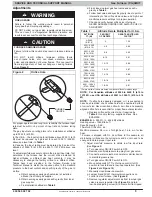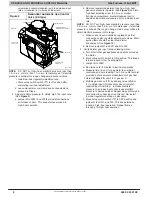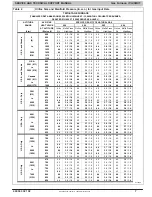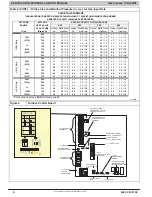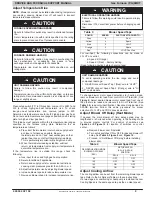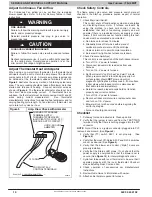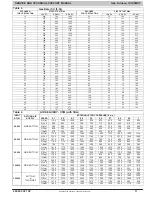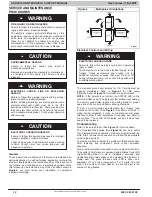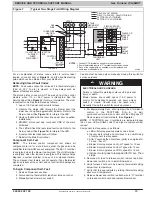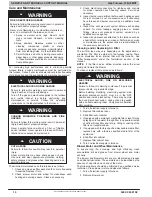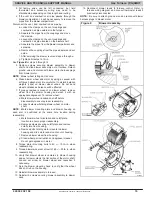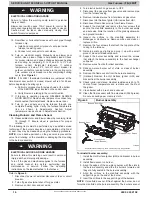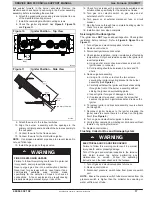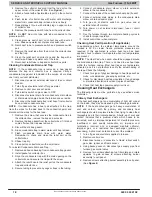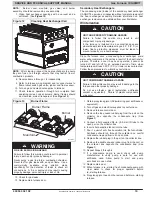
SERVICE AND TECHNICAL SUPPORT MANUAL
Gas Furnace: (F/G)9MXT
Specifications subject to change without notice.
440 04 4321 02
5
Adjustments
FIRE HAZARD
Failure to follow this warning could result in personal
injury, death and/or property damage.
DO NOT bottom out gas valve regulator adjusting screw.
This can result in unregulated manifold pressure and
result in excess overfire and heat exchanger failures.
!
WARNING
FURNACE DAMAGE HAZARD
Failure to follow this caution may result in reduced furnace
life.
DO NOT redrill orifices. Improper drilling (burrs,
outofround holes, etc.) can cause excessive burner
noise and misdirection of burner flames. This can result in
flame impingement of heat exchangers, causing failures.
(See
Figure 2
)
CAUTION
!
Figure 2
Orifice Hole
A93059
BURNER
ORIFICE
For proper operation and long term reliability the furnace input
rate must be 2 percent of input rate on furnace rating
plate.
The gas input rate on rating plate is for installation at altitudes
up to 2000 ft. (610 M).
In the U.S.A., the input rating for altitudes above 2000 ft. (610
M) must be reduced by 2 percent for each 1000 ft. (305 M)
above sea level refer to
Table 1
.
In Canada, the input rating must be derated by 5 percent for
altitudes of 2000 ft. (610 M) to 4500 ft. (1372 M) above sea
level.
To adjust manifold pressure to obtain the proper input rate, first,
determine if the furnace has the correct orifice installed. At
higher altitudes or different gas heat contents, it may be
necessary to change the factory orifice to a different orifice.
Tables have been provided in the furnace Service and
Technical Manual to match the required orifice to the manifold
pressure to the heat content and specific gravity of the gas. to
do this:
a. Obtain average yearly gas heat value (at installed
altitude) from local gas supplier.
b. Obtain average yearly gas specific gravity from local
gas supplier.
c. Find installation altitude in
Table 2
.
d. Find closest natural gas heat value and specific
gravity in
Table 2
.
e. Follow heat value and specific gravity lines to point of
intersection to find orifice size and lowand highheat
manifold pressure settings for proper operation.
f. Check and verify burner orifice size in furnace.
NEVER ASSUME ORIFICE SIZE. ALWAYS CHECK
AND VERIFY.
Table 1
Altitude Derate Multiplier for U.S.A.
ALTITUDE
FT. (M)
PERCENT
OF DERATE
DERATE MULTIPLIER
FACTOR*
0–2000
(0610)
0
1.00
2001–3000
(610914)
46
0.95
3001–4000
(9141219)
68
0.93
4001–5000
(12191524)
810
0.91
5001–6000
(15241829)
1012
0.89
6001–7000
(18292134)
1214
0.87
7001–8000
(21342438)
1416
0.85
8001–9000
(24382743)
1618
0.83
9001–10,000
(27433048)
1820
0.81
* Derate multiplier factors are based on midpoint altitude for altitude range.
NOTE
:
For Canadian altitudes of 2000 to 4500 ft. (610 to
1372 M), use USA altitudes of 2001 to 3000 ft. (610 to 914
M)
NOTE
: If orifice hole appears damaged or it is suspected to
have been redrilled, check orifice hole with a numbered drill bit
of correct size. Never redrill an orifice. A burrfree and squarely
aligned orifice hole is essential for proper flame characteristics.
g. Replace orifice with correct size, if required by
Table 2
. Use only factorysupplied orifices. See
EXAMPLE.
EXAMPLE:
0 - 2000 ft. (0 - 609.6M) altitude
Heating value = 1050 Btu/cu ft.
Specific gravity = 0.62
Therefore: Orifice No. 44
Manifold pressure: 3.4-in. w.c. for high heat, 1.4-in. w.c. for low
heat
* Furnace is shipped with No. 44 orifices. In this example, all
main burner orifices are the correct size and do not need to be
changed to obtain proper input rate.
1. Adjust manifold pressure to obtain low fire input rate.
(See
Figure 3
)
a. Turn gas valve ON/OFF switch to OFF.
b. Remove manifold pressure tap plug from gas valve.
c. Connect a water column manometer or similar device
to manifold pressure tap.
d. Turn gas valve ON/OFF switch to ON.
e. Move setup switch (TT) on furnace control to ON
position to lock furnace in lowheat operation. (See
Figure 4
and
Figure 15
)
f. Manually close blower door switch.
g. Jumper R and W/W1 thermostat connections on
control to start furnace. (See
Figure 4
)
h. Remove regulator adjustment cap from low heat gas
valve pressure regulator (See
Figure 3
) and turn
lowheat adjusting screw (3/16 or smaller flattipped


